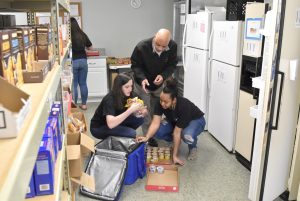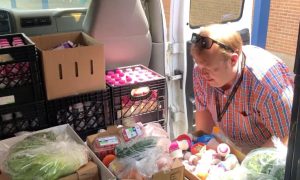By Ginny Wray
Thousands of pounds of food that might have ended up in the garbage now are helping feed needy residents of Henry County and Martinsville.
The program, called Feeding Hope in MHC, uses volunteers to collect unopened, prepackaged food from area school cafeterias and other sources and deliver it to Grace Network and the Salvation Army, which distribute it to people in need.
It began in mid-January and by the time school ended in late May, an estimated 8,564 pounds of food were collected and redistributed, according to figures compiled by Tracy Hinchcliff, executive director of Grace Network.
“We have been extremely pleased with the outcomes of the project,” Hinchcliff stated. “The schools were very accepting of the process and we have been able to redistribute so much of the product that would otherwise have been discarded.”
Referring to Grace Network and the Salvation Army, she said, “We have both had wonderful feedback from our clients receiving this product and (it) is much appreciated.”
The program takes advantage of unopened breakfast and lunch foods that students place on “sharing tables” in their school cafeterias for other children to help themselves to, according to Philip Wenkstern, executive director of the United Way of Henry County and Martinsville, and Hinchcliff.
But in the past not all the food was taken from the sharing tables so it was discarded.
Wenkstern said he and Monica Hatchett of the Henry County Public Schools talked about the leftover food and knew there were families in the community who would benefit from the milk, cheese, fruit and other items.
“We knew there were some challenges with respect to adhering to food safety guidelines and ensuring school buy-in, so she (Hatchett) did a lot of work ensuring the processes would work for the school systems,” Wenkstern stated.
Grace Network and the Salvation Army helped fine-tune the program, he said, and Harvest Foundation grants were used to buy refrigerators to store the food at the schools and ice chests to transport it. Harvest provided a $7,525 Pick up the Pace! (PUP) grant and the Harvest Youth Board gave a $2,555 grant for the equipment last fall.
Now, instead of going in the garbage, the food that is not eaten by the students goes to Feeding Hope.
Volunteers were recruited to pick up and deliver the food to both Grace Network and the Salvation Army. One of them is DeWitt House, senior program officer with the Harvest Foundation and a former educator with both the Henry County and Martinsville schools. He learned of the program during the Harvest grant application process and found he could fit volunteering into his work schedule.
“I’ve been in the schools for 32 years and seen a lot of food thrown away. The idea of being able to take food and get it to people who need it and appreciate it and benefit from it is very rewarding,” he said, adding that more volunteers would be welcome.
Grace Network distributed the food to clients who qualify for its food pantry, and the Salvation Army distributed it to clients during its weekly feeding program. Both agencies are continuing their usual food programs this summer even though Feeding Hope has shut down for the summer when schools closed. It will resume in the fall, Hinchcliff said.
Angie Smith, social services director for the local Salvation Army, said it received “a little bit of everything” through the program, such as milk, juices, fruit, vegetables and other items.
Sometimes the cooks used the milk to prepare the meals it serves, but most of it was given to clients to take home, Smith said. Generally, the volunteers dropped off the food by 10 or 11 a.m. and it was gone by 1 p.m., she added.
“They take it home for their children to eat when they get home, and they eat off it until they can go to another soup kitchen” or other source of food, she said.
The Army usually serves 50 to 90 people in its feeding program on Wednesdays and Fridays. Smith said that food is donated by area businesses and collected in an annual canned food drive conducted between October and December.
Although the Feeding Hope program did not operate for the full year, it was ahead financially.
According to Hinchcliff’s calculations, the food is valued at $1 a pound for a total of $8,564. The program’s volunteers average two hours of work each week with a value of $25.43 an hour, for a total of $5,289.
So the program’s total value for half of its first year was $13,853, which exceeded the initial investment of $10,080 in the Harvest grants, she said.
With no further monetary investment needed, “our return on investment will prove to be very successful,” Hinchcliff said.
Wenkstern agreed.
“The biggest expenses for the grant were the refrigerators, which should last at least 10 years. As long as students at the school system continue contributing uneaten food from lunch and breakfast I think the program will provide a tremendous return on investment while addressing some pressing challenges in the community,” he stated in an email.
Hatchett, who is the county schools’ director of communications and organizational learning, echoed that.
“We have been so grateful to partner with Grace Network and Salvation Army to return unused food to our community rather than discarding it. I’m not sure any of us knew exactly what to expect when we started, but I think we have all been very pleasantly surprised with how well things have gone and we are certainly looking forward to continuing this important partnership for years to come,” she stated, also in an email.
All those interviewed said they expect the program to continue next year, and two had suggestions for it. Smith at the Salvation Army said it would be helpful to find ways to make the volunteers’ pickups at the schools easier and also to try and continue the program in the summer.
Wenkstern suggested that the program be promoted to students and school staffs at the start of the school year.
That would “ensure that they are aware of the positive impact their choices can have on the community,” he said.






